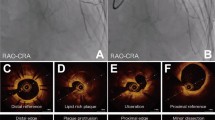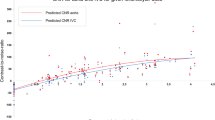Abstract
Low-molecular-weight dextran (LMWD) is considered a safe alternative to contrast media to displace blood during optical coherence tomography (OCT) imaging, but concerns remain. The purpose of this study was to investigate whether using LMWD for OCT protects against kidney injury in patients with renal insufficiency compared with contrast media. We retrospectively identified 474 patients with renal insufficiency (estimated glomerular filtration rate < 60 ml/min/1.73 m2) who underwent OCT during coronary angiography or percutaneous coronary intervention; 110 patients with LMWD plus contrast medium (LMWD group) and 364 patients with contrast medium exclusively (Contrast group). We evaluated differences between the two groups and performed propensity score-matched subgroup comparisons. Compared with the Contrast group, the LMWD group had worse baseline renal function, higher prevalence of diabetes mellitus and percutaneous coronary intervention history, higher C-reactive protein and N-terminal pro B-type natriuretic peptide levels, lower hemoglobin levels, and lower left ventricular ejection fraction. The median total volume of contrast medium in the Contrast group was 230.0 ml vs. 61.8 ml of LMWD in addition to 164.0 ml of contrast medium in the LMWD group. Renal function was consistently impaired in the LMWD group within 5 days, at 1-month, and 1-year follow-up (P < 0.001). Two propensity score-matched analyses adjusted for either total volume used or contrast media volume consistently indicated a trend toward worsening renal function in the LMWD group at the 1-year follow-up. No protective benefit for renal function from using LMWD instead of contrast media for OCT was observed in patients with renal insufficiency.




Similar content being viewed by others
Data availability
The data is available and permission might be sought per reasonable request.
Abbreviations
- ACS:
-
Acute coronary syndrome
- AKI:
-
Acute kidney injury
- CAD:
-
Coronary artery disease
- eGFR:
-
Estimated glomerular filtration rate
- LMWD:
-
Low-molecular-weight dextran
- OCT:
-
Optical coherence tomography
- PCI:
-
Percutaneous coronary intervention
References
Gruberg L, Mintz GS, Mehran R, Gangas G, Lansky AJ, Kent KM et al (2000) The prognostic implications of further renal function deterioration within 48 h of interventional coronary procedures in patients with pre-existent chronic renal insufficiency. J Am Coll Cardiol 36:1542–1548
Rihal CS, Textor SC, Grill DE, Berger PB, Ting HH, Best PJ et al (2002) Incidence and prognostic importance of acute renal failure after percutaneous coronary intervention. Circulation 105:2259–2264
Mehran R, Dangas GD, Weisbord SD (2019) Contrast-associated acute kidney injury. N Engl J Med 380:2146–2155
Wang F, Peng C, Zhang G, Zhao Q, Xuan C, Wei M et al (2016) Delayed kidney injury following coronary angiography. Exp Ther Med 12:530–534
Prati F, Regar E, Mintz GS, Arbustini E, Di Mario C, Jang IK et al (2010) Expert review document on methodology, terminology, and clinical applications of optical coherence tomography: physical principles, methodology of image acquisition, and clinical application for assessment of coronary arteries and atherosclerosis. Eur Heart J 31:401–415
Prati F, Guagliumi G, Mintz GS, Costa M, Regar E, Akasaka T et al (2012) Expert review document part 2: methodology, terminology and clinical applications of optical coherence tomography for the assessment of interventional procedures. Eur Heart J 33:2513–2520
Meneveau N, Souteyrand G, Motreff P, Caussin C, Amabile N, Ohlmann P et al (2016) Optical coherence tomography to optimize results of percutaneous coronary intervention in patients with non-ST-elevation acute coronary syndrome: results of the multicenter, randomized DOCTORS study (Does Optical Coherence Tomography Optimize Results of Stenting). Circulation 134:906–917
Kubo T, Shinke T, Okamura T, Hibi K, Nakazawa G, Morino Y, et al. Optical frequency domain imaging vs. intravascular ultrasound in percutaneous coronary intervention (OPINION trial): one-year angiographic and clinical results. Eur Heart J. 2017;38:3139–47.
Brezinski M, Saunders K, Jesser C, Li X, Fujimoto J (2001) Index matching to improve optical coherence tomography imaging through blood. Circulation 103:1999–2003
Ozaki Y, Kitabata H, Tsujioka H, Hosokawa S, Kashiwagi M, Ishibashi K et al (2012) Comparison of contrast media and low-molecular-weight dextran for frequency-domain optical coherence tomography. Circ J 76:922–927
Frick K, Michael TT, Alomar M, Mohammed A, Rangan BV, Abdullah S et al (2014) Low molecular weight dextran provides similar optical coherence tomography coronary imaging compared to radiographic contrast media. Catheter Cardiovasc Interv 84:727–731
Feest TG (1976) Low molecular weight dextran: a continuing cause of acute renal failure. Br Med J 2:1300
Moran M, Kapsner C (1987) Acute renal failure associated with elevated plasma oncotic pressure. N Engl J Med 317:150–153
Zwaveling JH, Meulenbelt J, van Xanten NH, Hene RJ (1989) Renal failure associated with the use of dextran-40. Neth J Med 35:321–326
Dickenmann M, Oettl T, Mihatsch MJ (2008) Osmotic nephrosis: acute kidney injury with accumulation of proximal tubular lysosomes due to administration of exogenous solutes. Am J Kidney Dis 51:491–503
Terada N, Kuramochi T, Sugiyama T, Kanaji Y, Hoshino M, Usui E et al (2020) Ventricular fibrillation during optical coherence tomography/optical frequency domain imaging - a large single-center experience. Circ J 84:178–185
Clinical practice guidebook for diagnosis and treatment of chronic kidney disease 2012: Tokyo Igakusha; 2012.
KDIGO (2012) Clinical practice guideline for the evaluation and management of chronic kidney disease. Elsevier, New York
Mehran R, Faggioni M, Chandrasekhar J, Angiolillo DJ, Bertolet B, Jobe RL et al (2018) Effect of a contrast modulation system on contrast media use and the rate of acute kidney injury after coronary angiography. J Am Coll Cardiol Intv 11:1601–1610
Bleyer AJ, Shemanski LR, Burke GL, Hansen KJ, Appel RG (2000) Tobacco, hypertension, and vascular disease: risk factors for renal functional decline in an older population. Kidney Int 57:2072–2079
Mehran R, Aymong ED, Nikolsky E, Lasic Z, Iakovou I, Fahy M et al (2004) A simple risk score for prediction of contrast-induced nephropathy after percutaneous coronary intervention: development and initial validation. J Am Coll Cardiol 44:1393–1399
Balemans CE, Reichert LJ, van Schelven BI, van den Brand JA, Wetzels JF (2012) Epidemiology of contrast material-induced nephropathy in the era of hydration. Radiology 263:706–713
Karimi Galougahi K, Zalewski A, Leon MB, Karmpaliotis D, Ali ZA (2016) Optical coherence tomography-guided percutaneous coronary intervention in pre-terminal chronic kidney disease with no radio-contrast administration. Eur Heart J 37:1059
Ferraboli R, Malheiro PS, Abdulkader RC, Yu L, Sabbaga E, Burdmann EA (1997) Anuric acute renal failure caused by dextran 40 administration. Ren Fail 19:303–306
Klotz U, Kroemer H (1987) Clinical pharmacokinetic considerations in the use of plasma expanders. Clin Pharmacokinet 12:123–135
Nearman HS, Herman ML (1991) Toxic effects of colloids in the intensive care unit. Crit Care Clin 7:713–723
Acknowledgements
We thank all subjects for their participation and other colleagues for their support.
Author information
Authors and Affiliations
Contributions
All authors contributed to the study conception and design. Material preparation, data collection and analysis were performed by TM, TS, YK, MH, MY, MH, TN, KN, YY, NT and TK. The first draft of the manuscript was written by Toru Misawa and all authors commented on previous versions of the manuscript. All authors read and approved the final manuscript.
Corresponding author
Ethics declarations
Conflict of interest
The authors have no conflict of interest.
Ethical approval
This observational study was performed in compliance with our institutional ethics committee guidelines, and the study received its approval.
Informed consent
All patients provided written informed consent prior to participation in the study.
Additional information
Publisher's Note
Springer Nature remains neutral with regard to jurisdictional claims in published maps and institutional affiliations.
Supplementary Information
Below is the link to the electronic supplementary material.
Rights and permissions
About this article
Cite this article
Misawa, T., Sugiyama, T., Kanaji, Y. et al. Effect of contrast medium versus low-molecular-weight dextran for intracoronary optical coherence tomography in renal insufficiency. Int J Cardiovasc Imaging 37, 2603–2615 (2021). https://doi.org/10.1007/s10554-021-02245-9
Received:
Accepted:
Published:
Issue Date:
DOI: https://doi.org/10.1007/s10554-021-02245-9




